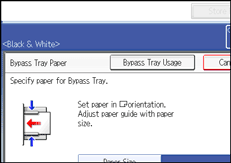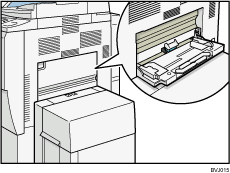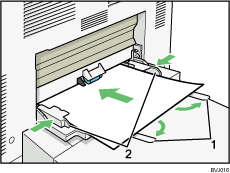Copying from the Bypass Tray
The bypass tray allows you to copy non-standard paper.
Use the bypass tray to copy onto OHP transparencies, adhesive labels, translucent paper, and paper that cannot be loaded in the paper trays.
![]()
The Duplex function cannot be performed on paper fed from the bypass tray. If [1 Sided
 2 Sided] is selected, cancel the setting. You can also change the initial settings. See “Changing the Default Functions of the Copy's Initial Display”.
2 Sided] is selected, cancel the setting. You can also change the initial settings. See “Changing the Default Functions of the Copy's Initial Display”.Paper that has a vertical length of 100 - 305 mm (3.94 - 12 inches) and a horizontal length of 148 - 457.2 mm (5.83 - 18 inches) can be copied from the bypass tray. (139 - 305 mm (5.48 - 12 inches) vertical length when prints are delivered to the finisher shift tray of Finisher SR5000.)
The machine can automatically detect the following sizes as regular size copy paper:
Metric version: A3
 , A4
, A4
 , A5
, A5
 , 8 × 13
, 8 × 13 , 100 × 148 mm
, 100 × 148 mm
Inch version: A3
 , A4
, A4 , 11 × 17
, 11 × 17 , 81/2 × 14
, 81/2 × 14 , 81/2 × 11
, 81/2 × 11
 , 51/2 × 81/2
, 51/2 × 81/2 , 100 × 148 mm
, 100 × 148 mm
If you want to use the size of paper other than the above, be sure to specify the size.
When copying onto OHP transparencies, paper of 65 g/m2 (about 17 lb. Bond) or less, or paper of 81 g/m2 (about 20 lb. Bond) or above, you need to specify the type and size of paper under Tray Paper Settings in User Tools. For details about Tray Paper Settings, see “System Settings”, Network and System Settings Reference
 .
.Do not use color OHP transparencies that have easily melted coatings.
The maximum number of sheets you can load at the same time depends on paper type. Load only as much paper as can be held between the paper guides on the bypass tray.
[Bypass Tray Usage]
Press [Bypass Tray Usage] to display a description on using the bypass tray.

![]() Open the bypass tray.
Open the bypass tray.

![]() Insert the paper face up until you hear the beep, and then align the paper guides to the paper size.
Insert the paper face up until you hear the beep, and then align the paper guides to the paper size.
If the guides are not flush against the paper, images might be skewed or paper misfeeds might occur.

Extender
Paper guides
![]() Press [Bypass], and then press the [
Press [Bypass], and then press the [![]() ] key.
] key.
![]() Select the size and type of the paper.
Select the size and type of the paper.
![]() Press [OK].
Press [OK].
![]() Place the originals, and then press the [Start] key.
Place the originals, and then press the [Start] key.
![]() When the copy job is finished, press the [Clear Modes] key to clear the settings.
When the copy job is finished, press the [Clear Modes] key to clear the settings.
![]()
Certain types of paper might not be detected properly when placed on the bypass tray. If this happens, remove the paper and place it on the bypass tray again.
Load only as much paper as can be held between the guides on the bypass tray. Overloading the bypass tray can result in misfeeds and skewed images.
The following paper sizes can be selected as the standard sizes:
A3
 , A4
, A4
 , A5
, A5
 , A6
, A6 , B4 JIS
, B4 JIS , B5 JIS
, B5 JIS
 , B6 JIS
, B6 JIS , 12 × 18
, 12 × 18 , 11 × 17
, 11 × 17 , 81/2 × 14
, 81/2 × 14 , 81/2 × 13
, 81/2 × 13 , 81/2 × 11
, 81/2 × 11
 , 81/4 × 14
, 81/4 × 14 , 81/4 × 13
, 81/4 × 13 , 8 × 13
, 8 × 13 , 8 × 101/2
, 8 × 101/2
 ,
,8 × 10

 , 71/4 × 101/2
, 71/4 × 101/2
 , 51/2 × 81/2
, 51/2 × 81/2 , 11 × 15
, 11 × 15 , 11 × 14
, 11 × 14 , 10 × 15
, 10 × 15 , 10 × 14
, 10 × 14 , 100 × 148 mm
, 100 × 148 mm
To support A4
 , 81/2 × 11
, 81/2 × 11 or larger paper sizes, pull out the extender.
or larger paper sizes, pull out the extender.To prevent multiple sheets from being fed at once, fan paper before placing it on the tray.
When the Sort function is selected, press the [
 ] key after all originals have been scanned.
] key after all originals have been scanned.When the Panel Key Sound is turned off, it will not sound if you insert paper into the bypass tray. For details about Panel Key Sound, see “System Settings”, Network and System Settings Reference
 .
.Printing on special paper such as OHP transparencies and thick paper may be slower than printing on plain paper.
When copying onto translucent paper, you need to specify the type and size of the paper.
When copying multiple originals using the bypass tray, pages are delivered in reverse order because the factory default setting is face up. You can change the settings under Copy Eject Face Method in Bypass Mode in User Tools.
If you place originals on the exposure glass and want the copies to be delivered face down, select Face Down for both Copy Eject Face Method in Glass Mode and Copy Eject Face Method in Bypass Mode of User Tools.
When copying onto special paper such as adhesive labels, always select Face Up under Copy Eject Face Method in Bypass Mode of User Tools. If you select Face Down, a paper misfeed may occur.
For details about Copy Eject Face Method in Glass Mode and Copy Eject Face Method in Bypass Mode, see “Input/Output”.
If you select Tab Stock (paper weight up to 199 g/m2, 110 lb. Index), you cannot have copies delivered face up.
If you select OHP (Transparency), Label Paper, Thick Paper 2, or Thick Paper 3 in Paper Type: Bypass Tray, you cannot have copies delivered face down.
Depending on the environment where the machine is being used, you might at times hear a rustling noise from paper moving through the machine. This noise does not indicate a malfunction.
We recommend that you use a 4000ANSI lumen or brighter overhead projector to project OHP transparencies.

